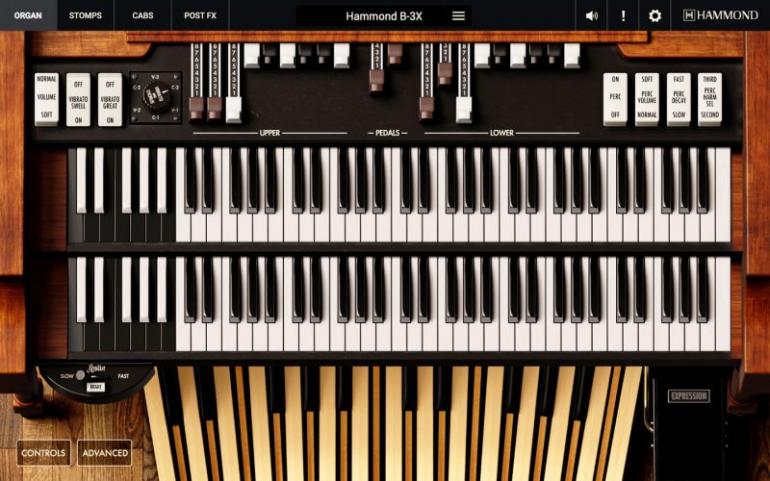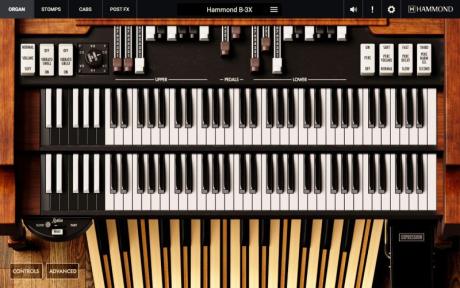Rockové klávesy - Reálné vs. virtuální: Hammond B3 vs. IK Multimedia Hammond B3-X
Real vs virtual B3 shoot out: Hammond B3 vs IK Multimedia’s Hammond B3-X

As a Hammond organist, especially one living in NYC without a car, I'm constantly searching for an lightweight, easy to use alternative to lugging the 400 lb monster around the lower east side. Enter IK Multimedia's ground breaking new software, the Hammond B3-X. The application, which even runs on an iPad, was the brain child of Hammond Suzuki and IK Multimedia's visionary programmer, Erik Norlander. Never before has there been so much control over an organ's parameters, tone sculpting, and effects.
Spinning wheel… got to go round
The B3-X has 91 free-running virtual tonewheels, painstakingly modeled after the most pristine B3s. There’s plenty of deep dive potential as all features including key click, leakage, and crosstalk can all be dialed in exactly to the user's taste. The visual layout of the program looks very clean and has a view that removes the key manuals for easy operation at the gig. The B3-X also has spot on percussion and vibrato which, you guessed it, have deep editing possibilities as well.

Extra features that seal the deal
The software features a cool pedal board with several classic stop boxes that sound just as great as the organ does. Classic overdrive, EQ, chorus, wah wah, and spring reverb are included. The CABS section of the software lets you mix and match Leslie amps and cabinets. There are even a few guitar stacks in the options for distorted organ bliss. You can get just the right ambience with tweakable mic paramaters, Leslie speed, acceleration, and deceleration. As if this wasn't enough, The B3-X has included rack mounted limiter, EQ, and reverb effects for even more tone sculpting possibilities.
Bomparisons between virtual and real B3s
I will say that being behind a real B3 that’s working well is an amazing experience. Unfortunately, when you are on the road, it can be very common to get an organ that is not quite up to snuff, or even worse, won’t turn on when it’s time to play! For me, personally, this software is a life changer. I can now travel easily with a super sleek, great sounding virtual organ. I was really blown away by this software. The meticulousness of design and hipness of the effects make the B-3X by far the best organ simulator on the market. This software is the first truly convincing B3 option running on an iPad as well. For you organists that like to split a one manual keyboard for both manuals an, update due out anytime will also have a split function. If you are a working Hammond organist, you need this software.
Video of me demoing software:
https://www.youtube.com/watch?v=f0AeSznY52g
IK’s product page: https://www.ikmultimedia.com/products/hammondb3x/index.php#realism
Fráze a hudební termíny
Lug around: Mírně pejorativní sloveso, které se používá ve smyslu „tahat s sebou něco nadměrně těžkého“. Narazíte na něj de facto pouze v případech, kdy někdo na koncerty či zkoušky vozí těžký aparát či nástroj (jako např. Hammondky) a poněkud ho to začíná štvát.
Tone sculpting: Tento výraz znamená „tvarování“ či vyladění zvuku do nejmenšího detailu (ať už pomocí efektů, nebo jiným způsobem).
Leakage, crosstalk: Je poněkud matoucí, že se tyto dva výrazy často vyskytují společně (i Brian píše leakage and crosstalk), protože znamenají to samé. V angličtině je to však poměrně běžné - redundance se používá jako určité zdůraznění (v právní angličtině je běžné např. „cease and desist“, což obojí znamená „přestat“). Ale zpět od lingvistiky k hudbě. Leakage i crosstalk značí přeznívání sousedních tónových generátorů. Podobně jako u klavíru narazíme na „sympathetic resonance“, tedy rozeznění sousedních strun při hře jednoho konkrétního tónu, i u elektromagnetických varhan může snímač jednoho tónového generátoru „zaslechnout“ zvuk těch sousedních (nebo zkrátka jiných). Přestože sám vynálezce Laurens Hammond vnímal přeznívání jako konstrukční vadu (stejně jako „keyclick“ - cvaknutí na počátku tónu), dnes je považováno za nedílnou součást zvuku Hammondek, a to do té míry, že ho digitální simulace záměrně modelují.
Acceleration, decelaration: Když přepínáme mezi dvěma rychlostmi efektu Leslie (nebo skutečné „Leslie bedny“) důležitým parametrem je zrychlování (acceleration) a zpomalování (deceleration) rotace. V tomto ohledu je třeba vnímat odděleně výškové horny a (středo)basový buben. Horny bývají dvě, takže se při shodné rychlosti rotace osy zdá jejich pulzování dvakrát rychlejší. Většinou jim také trvá přechod z jedné rychlosti na druhou mnohem kratší dobu než bubnu (jeho rotace má kvůli vnitřní hmotnosti větší setrvačnost). To vše musí dnešní simulace brát v potaz, chtějí-li znít realisticky.




